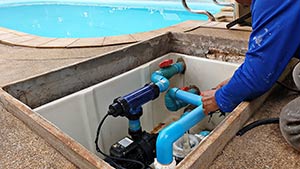Fixed Gas Detection and Chlorine Gas.
The HSE EH40 is a guidance note published by the Health and Safety Executive (HSE) for the United Kingdom. It provides information on the control of exposure to hazardous substances at work.
The note includes a list of Workplace Exposure Limits (WELs) for over 500 substances. WELs are the maximum concentrations of a substance that a worker can be exposed to over an eight-hour working day (long term), or 15 minutes (short term).
“British occupational exposure limits are set in order to help protect the health of workers. WELs are concentrations of hazardous substances in the air, averaged over a specified period of time, referred to as a time-weighted average (TWA). Two time periods are generally used:
■ long-term (8 hours); and
■ short-term (15 minutes).”
Source: https://www.hse.gov.uk/pubns/priced/eh40.pdf
The HSE recommends that employers use fixed gas detection systems to continuously monitor the workplace for hazardous substances including those operating within the hospitality or leisure industries that use or store chlorine, such as:
- Swimming Pools
- Saunas
- Hot Tubs
- Spas
- Jacuzzis
Gas hazards in swimming pools
Chemicals found in swimming pools and Spa plant rooms include Sodium Hypochlorite, Hydrochloric Acid, Bromine, Carbon Dioxide, Ozone Gas, and Chlorine. If not used or stored correctly, these substances can cause serious harm to both workers and the public by creating a toxic atmosphere.
Chlorine is a particularly hazardous substance. It is a greenish-yellow gas with a strong, irritating odour. It is a highly reactive chemical that can be used for a variety of purposes, including paper manufacturing, textile bleaching, and mainly water purification in swimming pools.
It is recommended the value of swimming pool chlorine should be between 1 – 1.5 parts per million (ppm) to ensure swimmers’ safety. Calculating the right amount of chlorine that you need for your spa or swimming pool is therefore crucial to avoid any risks of high concentration.
The risks of chlorine in swimming pools

When it contacts the throat, eyes and lungs, it can seriously damage these parts of the body.
Symptoms of exposure to high levels of chlorine include coughing, wheezing, tightness of the chest, nausea, vomiting, skin burns, eye irritation, and seizures.
The degree of poisoning resulting from chlorine depends on the level of exposure and the length of time the person is exposed to the gas. At low concentrations of chlorine exposure such as 1 to 3 ppm, those affected may have eye or oral irritation. Around 15 ppm there can be an outbreak of pulmonary symptoms, and exposure of around 30 minutes at 430 ppm can cause death.
How to prevent chlorine gas exposure in swimming pools?
For employers to help protect their workers and customers from the dangers of chlorine gas exposure in swimming pools and spas, a fixed detection solution is key. With the initial hazard coming from the plant room, a fixed system placed in this area should be the first consideration. The detector should be installed close to the points where chemicals will be mixed, providing the earliest warning of a toxic gas leak.
Once a fixed gas detection system has been installed, it is important to have it regularly serviced and calibrated. This will ensure that the system is working properly and that it will provide accurate readings.
Check out our contact us page to view our range of fixed gas detectors or call us today on
02920 759 683 for advice from our experienced engineers in the installation and maintenance of fixed detectors.
Written & Edited by Len Bridgeman and Sabrina Toumi





